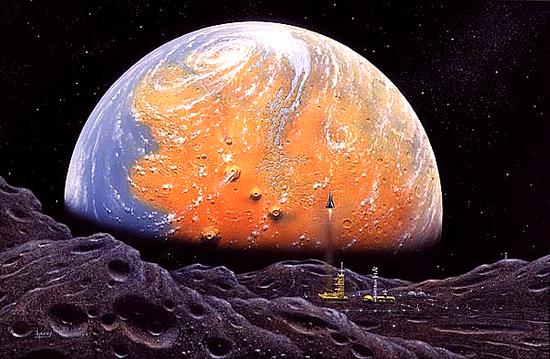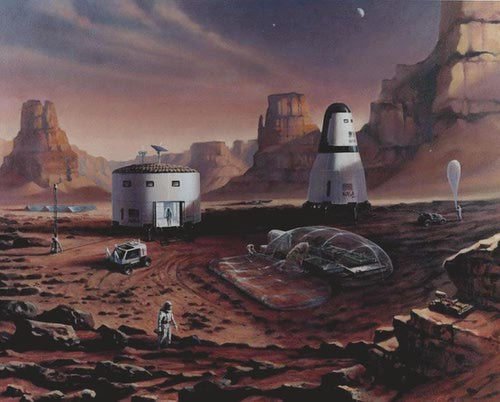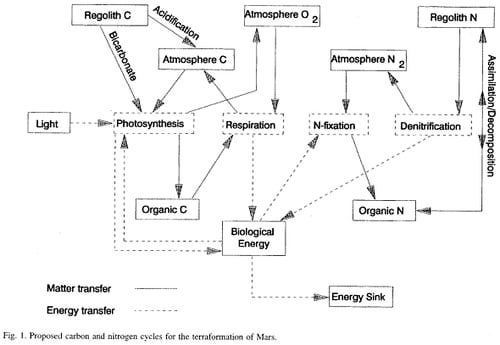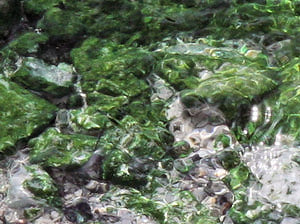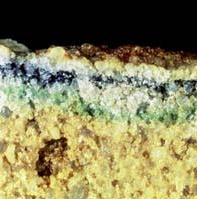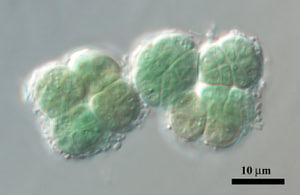Terraforming: Difference between revisions
| Line 34: | Line 34: | ||
Describe the physical, chemical, or spatial characteristics of the niche where we might find this interaction, using as many sections/subsections as you require. Look at other topics available in MicrobeWiki. Create links where relevant. | Describe the physical, chemical, or spatial characteristics of the niche where we might find this interaction, using as many sections/subsections as you require. Look at other topics available in MicrobeWiki. Create links where relevant. | ||
[[image:Marsview5.jpg|thumb|| | [[image:Marsview5.jpg|thumb||500px||right|http://www.antarcticaedu.com/visions/]] | ||
<br> | |||
<br> | |||
<br> | |||
<br> | |||
<br> | |||
<br> | |||
<br> | |||
<br> | |||
<br> | |||
<br> | |||
<br> | |||
<br> | |||
==Microbial processes== | ==Microbial processes== | ||
Revision as of 02:29, 5 April 2012
Terraforming
Terraforming or “Planetary Ecosynthesis” is the process of changing a planet’s atmosphere to resemble that of the Earth’s, with the goal of sustaining terrestrial life. It is predicted that establishment of life will be similar to Earth’s history, starting with basic unicellular microbial life. The most pheasible pioneer to begin life on a new planet would be some kind of photosynthetic microbe. (Graham)
Mars is the preferred planet of interest for terraforming though Venus, and various moons have also been proposed. Mars mostly consists of CO2 (95.3%) with very little O2 and N2. Mars only recieves 43% of the light Earth gets from the Sun, yet it is still sufficient enough for photosynthesis. The main purpose of photosynthetic microbes would be removal of CO2 while adding O2 to the atmosphere.
In the introduction, give a brief overview of the microbial interaction that is the topic of this page. Introduce the interaction, the organisms involved, the ecological significance of this interaction, and the importance of microorganisms and their processes in this environment (described in more detail below). What processes do they carry out? What functions do they perform? Why are microbes important in this interaction?
Biological interaction
Provide details of the symbiosis or biological interaction. Is this a specific or general interaction? How do these interactions influence the host or other microbial populations, and their activities? How do these interactions influence other organisms (positive or negative influences)? What is the outcome of this interaction? Are there ecological consequences? Describe biological interactions using as many sections/subsections as you require. Look at other topics available in MicrobeWiki. Create links where relevant.
Photosynthesis
Subsection 1b
Denitrification
Niche: A New World
To lay the foundation for microbial terraforming, the agreed plan is that the process starts with the release of man-made greenhouse gases into the atmosphere, heating the planet substantially, which will then cause CO2 evaporation from the planet’s own glaciers and soil, producing further warming. Melting glaciers will produce hydrologic cycles and evaporated H2O into the air, creating a denser atmosphere. This suggests a global temperature of at least 0 degrees Celsius. Water will be stable on the surface and temperatures will be more moderate, but the atmosphere will be mostly CO2 and have little O2. So long as UV radiation remains high, microorganisms will be confined to living in or under rocks. (Martyn Fogg 1995) UV radiation screens have been proposed for microbial access to surfaces. (Graham)
Describe the physical, chemical, or spatial characteristics of the niche where we might find this interaction, using as many sections/subsections as you require. Look at other topics available in MicrobeWiki. Create links where relevant.
Microbial processes
Mars has no tectonic activity so no biogeochemical cycling occurs there. It's thought that biological and photochemical processes can run the cycles on Mars.
Carbon cycling
Photosynthetic microorganisms removie CO2 from the atmosphere by photosynthesis:
6CO2 + 12H2O + Light -> C6H12O6 + 6O2+ 6H2O
Eventually heterotrophic microbes will release CO2 back into the atmosphere through respiration:
C6H12O6 + 6O2 --> 6CO2 + 6H2O + energy
Certain Microrganisms such as Matteia have been proposed to release CO2 from carbonate rock to complete the cycle in the early stages of colonization, just until enough enough carbohydrate is available to support heterotrophs.
Oxygen
Cyanobacteria and algae will be used to increase O2 through photosynthesis
6CO2 + 12H2O + Light -> C6H12O6 + 6O2+ 6H2O
Nitrogen cycling
Besides CO2 and O2, a buffer gas is needed to support human life, and nitrogen is necessary for photosynthesis at the start of terraformation.
Currently there is not enough N2 in Mars' atmosphere for nitrogen fixation and therefore, denitrifican is necessary as long as the regolith contains nitrate as is proposed
Denitrification:
NO3− → NO2− → NO + N2O → N2 (g)
Cyanobacteria can reduce N2 to ammonia:
N2 + 8 H+ + 8 e− → 2 NH3 + H2
Sulfur cycling
Most microbes utilize oxidized sulfur for protein synthesis.
Phosphorous cycling
Phosphates are insoluble minerals that are highly conserved in stable environments but through time losses can be a possible issue for terraformation. This may be the case with other non-volatile, minerals such as iron, manganese, and magnesium.
What microbial processes are important for this microbial interaction? Does this microbial interaction have some ecosystem-level effects? Does this interaction affect the environment in any way? Describe critical microbial processes or activities that are important in this interaction, adding sections/subsections as needed. Look at other topics in MicrobeWiki. Are some of these processes already described? Create links where relevant.
Key Microorganisms
What specific kinds of microbes are typically involved in this interaction? Or associated with important processes? Describe key groups (genera, species) of microbes that we find in this environment, and any special adaptations they may have evolved to survive in this environment. List examples of specific microbes that represent key groups or are associated with important processes found in this environment. Add sections/subsections as needed. Look at other microbe listings in MicrobeWiki. Are some of the groups of microbes from your environment already described? Create links to other MicrobeWiki pages where possible.
Cyanidium caldarium
A unicellular red algae found in diverse extreme environments such as bogs, wet acidic soils, and hot streams. It has been found to survive with little to no oxygen. (Sechbach et al.)
Cryptoendolith Lichens
Literally "hiding in rocks" An extremophile found in porous rock in Antarctica where temperatures are normally between -89.2°C to about -93.4°C and there is no rain or snowfall.
Chroococcidiopsis
Psuedomonads
Alcaligenes
Bacillus Polymyxa
Current Research
Enter summaries of recent research here--at least three required
References
Edited by <your name>, a student of Angela Kent at the University of Illinois at Urbana-Champaign.
